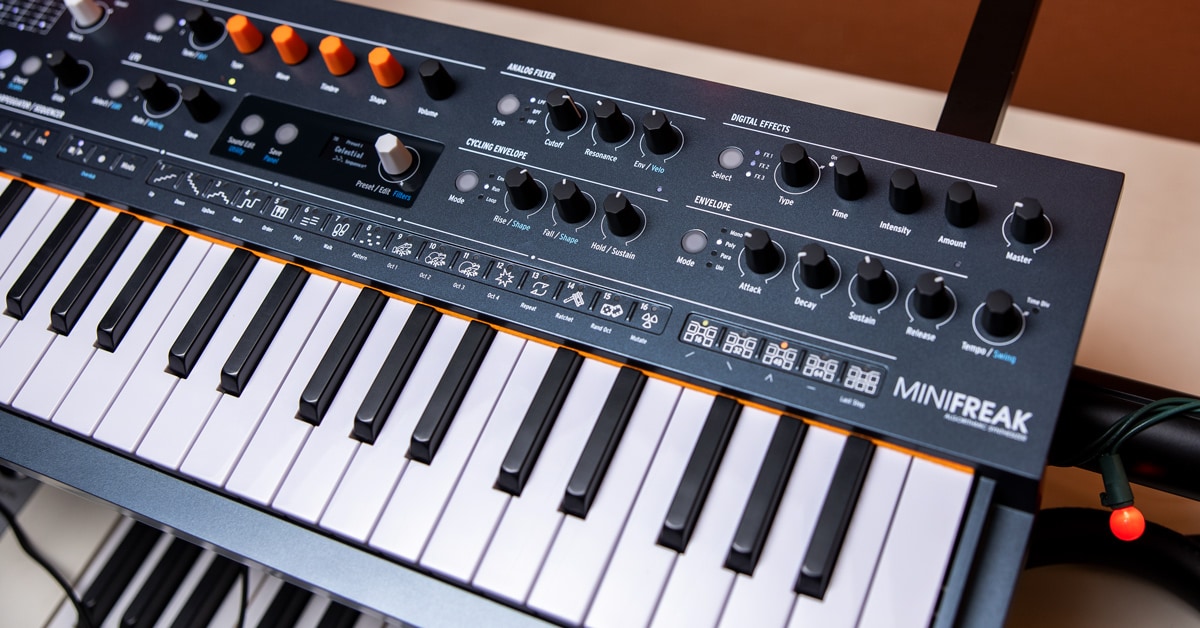With the release of the MiniFreak compact synth, it’s easy to see how the French “sound explorers” Arturia have cultivated an impressive following of sound designers and music makers alike. Much like its name, its design—featuring a blend of expressive, organic sonic character juxtaposed with a minimal, easy-to-use interface—beckons you to play it differently.
Sébastien Rochard, product manager at Arturia, was kind of enough to tell all in our Guitar Center-exclusive interview. He went into depth of what went into the design of the MiniFreak, as well as how Arturia’s firmware update ethic ensures this evolutionary one-of-a-kind instrument will be a mainstay for years to come.
Can you give us a little bit of your background at Arturia—when you joined, what you've worked on, etc.?
Sébastien Rochard: I joined Arturia as an intern in 2012, and I've been a full-time employee since 2014. I've done a few different things, but focused on product management, initially on Spark (this groovebox software with a controller). And then, lots of software in the V Collection, and at some point, I started designing more and more hardware—MiniBrute 2 and 2S.
I worked a lot on MicroFreak, PolyBrute, BeatStep Pro and KeyStep Pro, and a bit of MatrixBrute. Right now, I'm doing many things in the Brute and Step product families and the Freak family, with this new baby that we're going to talk about.
Did you go to school with this career in mind? What was your education background?
I've been playing musical instruments since I was like three or four years old, including classical instruments. I started using DAWs when I was around 14, and then, when I went to the equivalent of college in France, I didn’t even really know what I wanted to do. I liked sciences, and I also was making music on the side, and I figured, can I kind of mix these two together?
So, I applied to some companies for an internship, and Arturia was one of the ones who replied. And they're French, and they're not very far from where I lived. I went there for a year, started as a DSP engineer intern. At that time, I didn’t really know what I wanted to do in particular. I didn’t really know what it took for a product to exist. Like, what are the different phases in terms of research, design, development, etc.? And when I started digging into it through this experience at Arturia, I became fascinated with designing instruments—the aesthetic side of it, the musical side of it and also the technical one.
I've stayed in product management this whole time, and I want to continue designing instruments. This is what I love to do. You need to be aware of what’s technically possible, what people want, what musicians want, what they already can do, what's new and what frustrations they have, so you can develop instruments that fit all these factors.
Can you talk us through the early planning stages for MiniFreak? Obviously, it’s an extension of MicroFreak, which came out in 2019, but it’s not just a “slightly bigger version.”
There's something about how we name products at Arturia that kind of dictates what we do, in a way. Not in a bad way, of course. When we did MiniBrute, and then we did MicroBrute, we kind of already knew what it was going to be. And, so, when we had MicroFreak, and now MiniFreak, there’s an obvious logic behind it, just in the naming alone. It's almost a starting point. So, I would say that the idea of MiniFreak came up very early, even before MicroFreak existed. There are obvious things, like we could have more oscillators. We could have more voices of polyphony. We could have effects. These are things that come up naturally when you want to expand on the original instrument.
As we started to think about what we wanted to do with MiniFreak, we really dug into MicroFreak and distilled it down to its essence. We asked ourselves, “What do we want to keep, and what do we want to change?” The oscillator design was an obvious thing that we wanted to keep because it just works—having all these different forms of synthesis that are controlled with these three abstract knobs, with names that kind of tell you something, but don’t really tell you anything about. Just take a form of synthesis—then you get three knobs to have fun jamming with. We built upon that by adding two of them.
Next, there was the question of the keybed. As you look at the two synths, that’s an obvious difference between them. Discussions about polyphony were almost immediate. We wanted to have a polyphonic instrument. MicroFreak is paraphonic and there are some things that are very difficult to play because of how the fingers just sit on the keybed when you play it. Sometimes, you're going to hit a key or something when you want to play a complex chord, and because it's capacitive, it just triggers notes. With MiniFreak, it made more sense to have a more conventional keybed. It’s a slim keyboard. It’s the same one that we’ve been using on the KeyStep. Personally, I really, really like this keybed, because you can make an instrument that's not too big, and yet you still have something very playable.
So, expanding total voices, changing the keybed and adding effects were the big additions. We decided to keep the filter, though. I really love the filter of MicroFreak in the sense that it has character, but not too much character, and in a good way. For instance, when you compare the Steiner-Parker filter on the Brute instrument, it's got a lot of character, which is great on something where the focus is on the filter. On MicroFreak, and now MiniFreak, what we wanted was the digital part to shine. We want the oscillator to come through, because that's kind of what makes this instrument unique. So, having a two-pole 12dB filter, and having something that's more on the creamier, cleaner side, means that it's not taking away from the sound. It's not interfering too much with the sound of the oscillators.
It's complementary, but it doesn’t overwhelm, right?
That's right. So, we kept that. And then, I would say the last two things, one was the sequencer MicroFreak has a sequencer but because of its limited form factor, it is lacking on the UI side, having no metronome, and having no steps that you could write a sequence as efficiently as a KeyStep Pro, for example. So, we added that.
The last thing is improvement to the controls—having pitch bend, mod wheels and having two macros, so that you have quicker performance control on the sound.
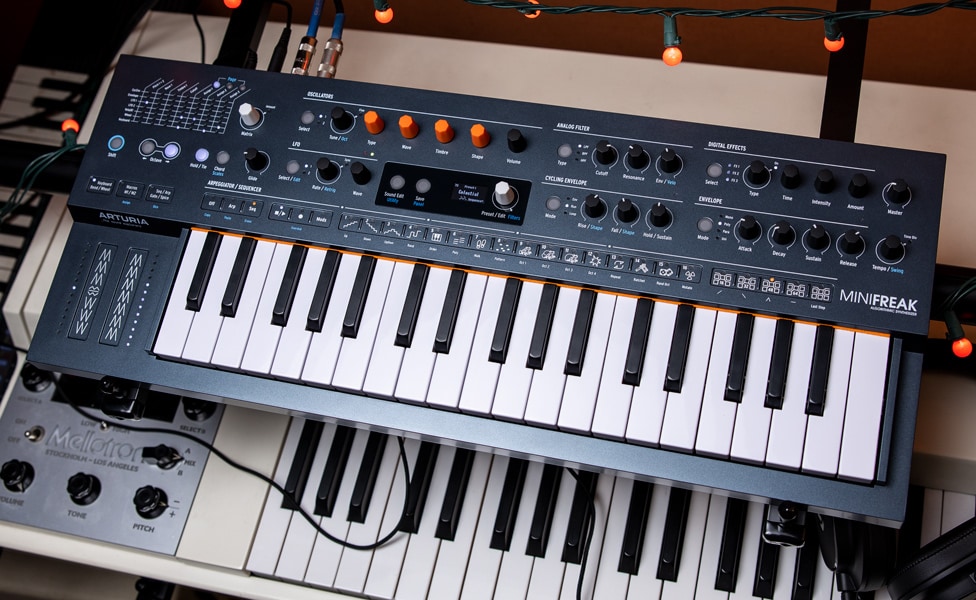
Did you find that the keybed on MiniFreak changed how you interacted with the synth engine?
This is a more personal note, but yes, totally. I tend to play with MicroFreak as a drum synth a lot more than as a sound instrument, because I feel like it has just the right amount of features to design snares and kick drums, and weird, metallic patches, and stuff like that. So, it is a drum tool for my uses, although [it] definitely does other things. Having polyphony on MiniFreak immediately makes you want to play more notes. Having the effects, with reverb, the patches blend into something that's longer and dreamier. So, yes, definitely—it calls for being played differently, I think.
As you were designing MiniFreak, did you find that you were designing for a sound that you wanted to hear, or designing for features that you wanted to add?
In the context of MiniFreak, I was aiming for a certain aesthetic in the sound. When you’re dealing with digital, anything is possible, and that’s not exactly what I wanted. I think kind of what I wanted is how analog is imperfect. What we like in analog is imperfection. I wanted that in digital. I wanted us to appreciate the fact that digital can sound nasty. Some things can sound erratic. You’ve got this whole glitch aesthetic. That was kind of the intent.
Ultimately, the instrument is more than just that. It can definitely do creamy patches. It can do virtual analog just as well.
But at the other extreme, users have access to 60dB of gain on the distortion effect. And there are three effect slots. Setting extreme gain on all three slots will lead to digital noise and aliasing. Did that make us want to limit the digital gain? Definitely not!
It’s not really that I have a sound in my mind, and I'm designing an instrument to make that sound. It's really more about the kind of vibe that I want to get. And I feel like we've touched that with MiniFreak in general. It's in the instrument's design, but it's just as much the sound design in the end. Like, telling the sound designers, “Here's kind of what I want. Make some simple VA patches, but then give me a control that turns it into something different, something more digital, something more aggressive. Don't give me cutoff and decay. That's not what I want. I want something edgier.”
MiniFreak’s predecessor, MicroFreak, originally came out in 2019. Three years later, it’s a pretty different synth than what you initially released, owing to the V2 and V3 firmware updates. Can you speak to that platform development, and your partnerships with Mutable Instruments and Noise Engineering?
Well, first, I would say that our product line has been growing quicker than it's been shrinking. We haven't discontinued many products because, especially with software, when we can improve on it, we just do. With MicroFreak in particular, it lends itself to be updated because of that oscillator and the control interface. It just says “Type” and has three knobs. So, that makes it easy to add features. When you’re dealing with an analog synth, or something where the UI is mainly buttons and LEDs, you can’t update it as easily because it may require adding features that aren’t labelled. That can get confusing for the user. With MicroFreak, that’s not the case. If we want to, we can just add on something. We could add 25 more mods to MicroFreak and it would still be MicroFreak, and the control experience would still be the same. So, we offered some pretty big updates for MicroFreak which, because of the way it’s designed, we were able to do in an elegant way. And then we did it because people loved it. It just made the whole instrument better.
Over the years of MicroFreak’s development, we’ve partnered with some outside companies, including Mutable Instruments and Noise Engineering. With Mutable Instruments, there's alignment between what we had in mind when we designed MicroFreak and the features of their module, Plaits. When we met with Émilie, we talked about whether or not it made sense to have individual instrument code inside. So, we did. We didn’t keep all of the oscillators, but we kept some of them.
Now, I've loved modular since about 2014. I've always loved Mutable Instruments, and Noise Engineering as well, for totally different reasons. So, we talked about doing something together. They made some of the engines I use the most. I just find them so versatile in their own kind of glitchy, messed-up way. That’s how the partnerships happened there.
All of that R&D over the past three years of MicroFreak development carries right over into MiniFreak, right?
Yeah. A lot of the oscillators of MicroFreak are in MiniFreak. There are some that are not there, and there are some that are new, but the vast majority are the same.
Can you touch on that a bit? What are the most obvious differences between the two synths, outside of their different sizes and keybeds?
MiniFreak has a two-oscillator design. Because we have two oscillators, one of the things we could do was either have two oscillators in parallel, or use the second oscillator as a digital filter in series that processes oscillator 1. So, I didn’t add more oscillator modes. I did filter modes, or at least modes that use the fact that there are two of them.
The first one—well, you have multi-mode filtering. You have some very sharp filtering, digital of course, and per voice. You have a phaser filter; you have a comb filter. You have bit crushing and a wave folder. And there's a mode, FM Ring Mod, where it takes oscillator 1 as the modulator to do FM (phase mod, technically), on oscillator 2. These are the new additions which use oscillator 1 to do something on the second oscillator.
There's also a new mode which uses the new audio input at the back so you can process. It works great with drum loops, just sequencing, syncing the two together and then processing them. The only one that's not here is the wavetable engine, because the way it was done on MicroFreak doesn’t lend itself well to integration with MiniFreak V, the plug-in version. I wanted to have something where you could easily drag and drop a wavetable into MiniFreak V and immediately have it on MiniFreak, because that was the whole integration promise. So, I took it out for now. I'm going to redo it in a way that's more aligned with what MiniFreak and MiniFreak V can do.
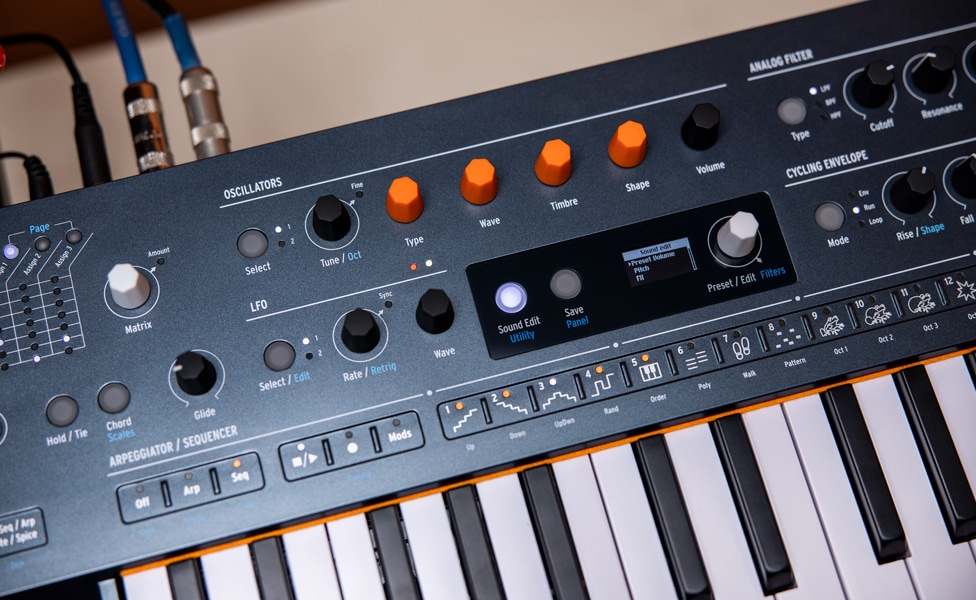
Given those differences, would you describe them the same way sonically? Or do you feel like MiniFreak has substantially diverged?
I would say that MicroFreak is included in MiniFreak, definitely, but that MiniFreak is so much more versatile. Obviously, the UX is very similar, and there’s a lot that’s carried over, but it goes so much beyond what was possible with MicroFreak. You can kind of do a MicroFreak patch on MiniFreak, you know? You just mute one of the oscillators—don't use the effects. But four-voice paraphony into one filter, you can't really do it [on MiniFreak]. It's either six-voice polyphony, or MiniFreak also has this mode where you can do paraphony using the two oscillators as two voices into each filter to get like 12 voices of half paraphony/half polyphony, but you can't really get these four voices into a single filter.
Besides that, in terms of sound, you get two LFOs instead of one, where you can draw the LFO shapes. The cycling envelope is very similar. The envelope is quite different—taken from PolyBrute. We've spent quite a bit of time designing the shape of the envelope, having something that feels snappy, that's not just like a simple exponential decay, but something that really feels nice when you apply it to a filter and to a VCA. All these sound refinements are a part of MiniFreak.
Are the effects brand-new algorithms, or are they inherited from some of your other products?
What we did with the effects, and for the digital filters for oscillator 2, is reuse some of what we built for Pigments. Some of the effects that we have in MiniFreak are taken from Pigments, and adjusted to fit with only three knobs, as well as the modulation matrix within MiniFreak. We've been using effects in many of our synths, and we've been refining them throughout. There's no point reinventing what chorus or phaser means for us. It's nice that we have these building blocks that we can grab and adapt to the UI specificities of each instrument. There are some things that are taken from Pigments, like the distortion engines and a multi-band compressor.
How do you stop yourself with such an incredible library to pull from? How do you narrow things down?
It has to be fun to use. And like with the oscillator modes, it has to work with only three knobs. It has to offer the user enough breadth of sound, so that there are no two parameters that conflict with each other. It takes time to refine something to the point that it's controlled with only three knobs in an elegant way. Could we add more? Definitely. Do we add more because we have something, and just figure out the three parameters that make the most sense and be done with it? No. That's not how we do it. So, there's room for expansion. There's room in the oscillators and the effects for extensions, among other things. Users can definitely expect that we're going to have new firmware versions down the road. But each time, it takes effort to do something that really works well with the UI.
One of the areas that I wanted to touch upon was the Cycling Envelope. That’s not exactly a common control you see on most other hardware synths.
With the Cycling Envelope, the inspiration was West Coast synthesis. It's basically an envelope that can loop. Essentially, you can change the rate of the attack, hold and release stages, and either have it free running or have it key re-triggered. So, every time you play, it restarts from the attack phase. On MiniFreak, if it's attack, hold, release (or attack, release, hold), you can change the state of it. And you can change the shape—for example, how linear or exponential each of the segment is.
It's basically in between an LFO and an envelope, in the sense that in an LFO, you have a given rate, and then the waveform may change in the middle. And in an envelope, you have independent length for each of the segments. And, here, it loops, but the attack, hold and release are independent—so it's kind of in between.
So, a different way to think of it is that a normal LFO would provide X amount of waveform shapes to choose from, and that’s it. In some ways, the Cycling Envelope lets you draw your own LFO shapes.
That's correct. And because it's possible, we also have a third mode for the Cycling Envelope, which is just an envelope mode where it's attack, decay, sustain, amplitude, and the release and decay, which are the same time because we only have three nodes, like a Minimoog.
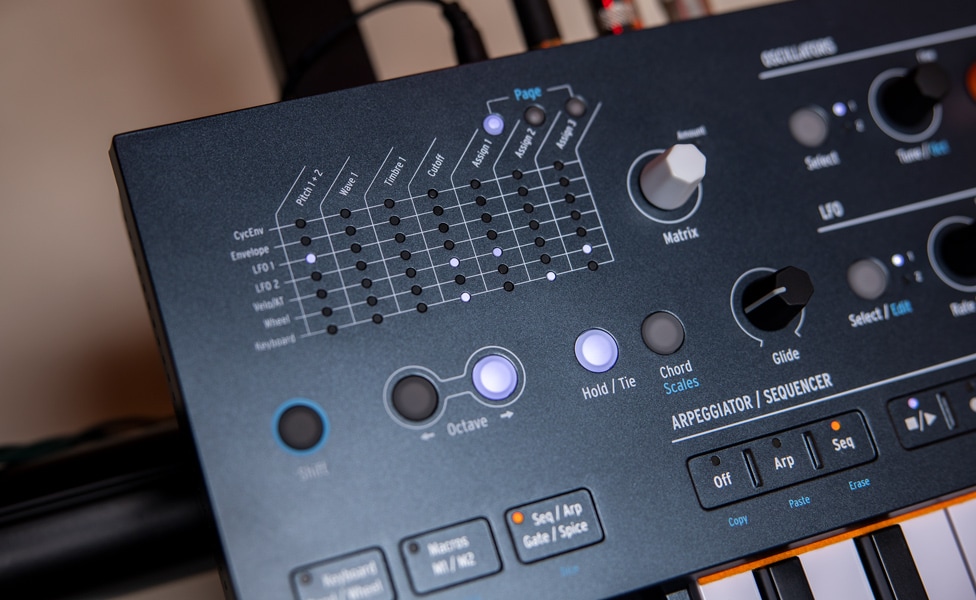
The modulation matrix has been expanded a bit. What's your favorite move with it? What would you use it for?
I love shaping the envelope just the way I want by applying the envelope to itself—like, if I want to carve in the decay, or things like assigning to the decay time, and then having a small negative or positive amount to carve the envelope time. I love doing things where I modulate the cycling envelope rate, so that you have something like a bouncing ball effect, that sort of thing.
I love modulating the effects. The fact that you can assign the effect parameter, and then modulate it with an envelope or the velocity, lets you do things like having a patch that starts with a lot of distortion on the attack, and then the distortion dies off—or the opposite. Or, you could have a reverb that only appears at the end, because the dry/wet is taken down until the sound releases. I love doing things like that, where the effects become part of the patch because they are modulate-able.
I want to go back to the “bouncing ball” that you talked about. It really conjures quite the vision. Can you describe that a little bit?
Well, a bouncing ball effect would be something where it kind of starts slow and then frequently becomes faster, because that’s kind of what happens when a ball bounces on the ground, where the repeats become closer to each other. So, you would start with a long release, and then progressively it would get shorter. And you could use another envelope for that, or you could use another LFO so that it repeats this bouncing ball effect.
For me, and maybe this is because of when I started learning about sound design, I’ve always used mod matrixes to try to get digital to sound a bit closer to analog. They’ve always been great to add a hint of modulation to get that analog drift, if you will—whether it was for pitch on one or more oscillators, whether it was for making the LFO slightly less perfect—really, any number of things. Can you talk about how you might approach that on MiniFreak?
Well, a great example is that you can use keyboard follow as one of the modulation sources. The regular keyboard follow just follows whatever note that's played, but there are three options for that, and I’ll explain two of them now. One mode is just “random.” So, every time you play a note, it generates a new random value per voice. That works perfectly if you want to have a bit of dispersion, for example and you want the keyboard value to modulate that. The other one mode is “voices.” What that does is that it assigns fixed values to each voice. For example, you can have 1, –0.5, 0, 0.5, 1, and each voice will retain its unique value. And so, what happens is that when you do use that to add a little bit of this modulation source to the pitch, to the filter, or even to the decay, it really gives you a sense of how different each voice is, and it gives that analog feel.
When you look at analog synths, they typically have a relatively small, fixed number of voices—1, 4, 8, etc. So, the effect kind of loops back in an easily observable manner. If you play five times on a Prophet-5, for example, you're going to hear it cycle through each voice quickly, and you’ll hear the uniqueness of each voice “loop back.” And that’s actually part of what makes this analog feel. It's not purely random. It cycles through the voices. So, this is a great feature on MiniFreak to really give you that analog vibe.
I want to talk a bit about the MiniFreak V software plug-in. It seems like it’s pretty much as 1:1 as you could get it, down to the filter, which you’ve modeled. As you look to the future of MiniFreak, do you anticipate they’ll be developed 1:1 in parallel, or is there perhaps a different opportunity for development on the different platform?
It will remain in parallel. MiniFreak V uses the code that MiniFreak uses to run. Some of the things had to be done differently, obviously, like MIDI synchronization, for example. But in general, the idea is that it runs the same code, and that if we evolve MiniFreak, MiniFreak V will evolve as well. The filter will not evolve, because it's analog, but whatever we do to the rest should also be applied in the software version.
The idea is that we’re keeping the same sound and performance from one to the other, so that people have the benefits of the physical hardware, for tweaking knobs, for example, but also the convenience of the software version. Sometimes you just want to get into your computer and produce a track with multiple instances [of MiniFreak], and go back and forth between different sounds, quickly going between minor changes and all that. At that point, having software instances is so much more convenient. But ultimately, the sound should remain the same between the two, which really gives users a lot of flexibility.
Does it also work as an editor/librarian for the hardware? Can you do essentially a SysEx dump to move your sounds back and forth?
Yes. You have a library of sounds in MiniFreak V. In fact, we’re probably going to add more sound banks in the future, so that we can give you a place to dump in MiniFreak. With MiniFreak V, you can visualize the presets that are in your MiniFreak. You can bring them back into the computer and do backups of your MiniFreak, and go back and forth between the computer and the machine. So, in terms of presets, you can do that.
As I mentioned, there’s the visualization aspect. You can load a preset on MiniFreak and see it on the interface of MiniFreak V, or you can do the opposite. You can load a preset in MiniFreak V and tweak it with your MiniFreak. That becomes a perfect integrated MIDI controller. You can write a patch on a plane with your computer, and then come home, put it in the hardware and go on stage with it—or you can do the opposite. It's all about blurring between computer and hardware, because both make sense in the production context. And there’s a gap between them, having to bounce to audio or having to do SysEx dumps. SysEx dump is a nasty term.
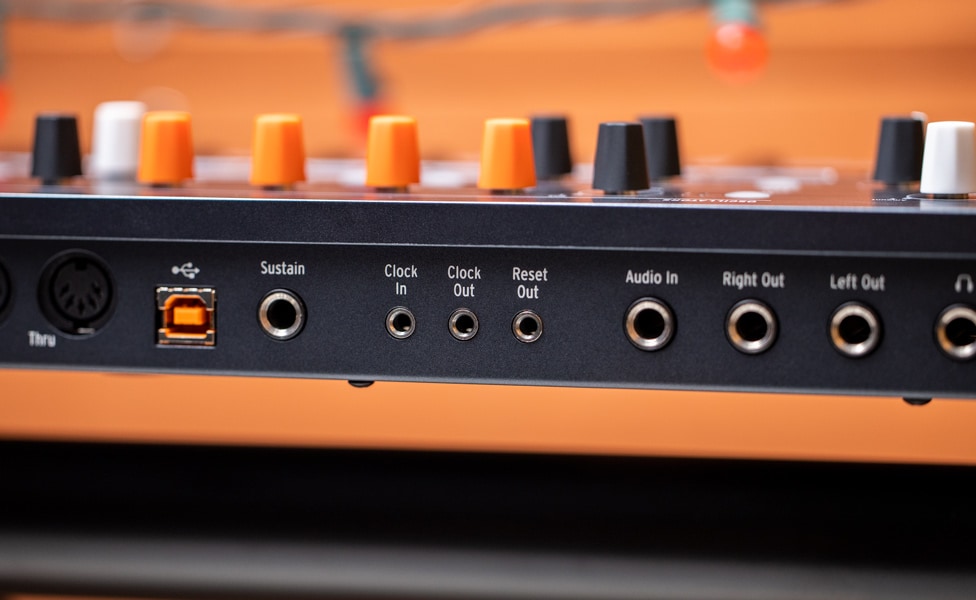
It sounds gross.
It sounds old.
It sounds old and gross!
Ultimately, it’s about figuring out how we can build the best experience where hardware just becomes part of working in a computer. That’s primarily how people are working today.
As you think about MiniFreak, I’m wondering if you could summarize it for us, with a few adjectives, the sound, the feel … the experience.
I wonder if I'm going to be lacking English at that point!
That might make it more fun. Feel free to throw in some French, too!
There's something about the sonic diversity. It's huge, especially for the size of the instrument. So, that would be the first thing.
There's something about the interface, where the screen is tiny, and it's never a problem. It feels like the controls that are here—they just make sense. The interface makes you want to just play it with your ears. If there's an adjective in English that sums up that, please, by all means use it!
It is definitely fun and inspiring.
I remember seeing MicroFreak for the first time at NAMM 2019, and even just aesthetically it was, like, “Okay!” It hit pretty hard. And that feeling will make you use it differently, because it puts you in a different mindset. And unboxing MiniFreak for the first time the other day—it was the same exact feeling.
Even the name, “Freak.” It makes you want to do it differently. It makes you want to use it differently. Throw out all the rules and just play differently.
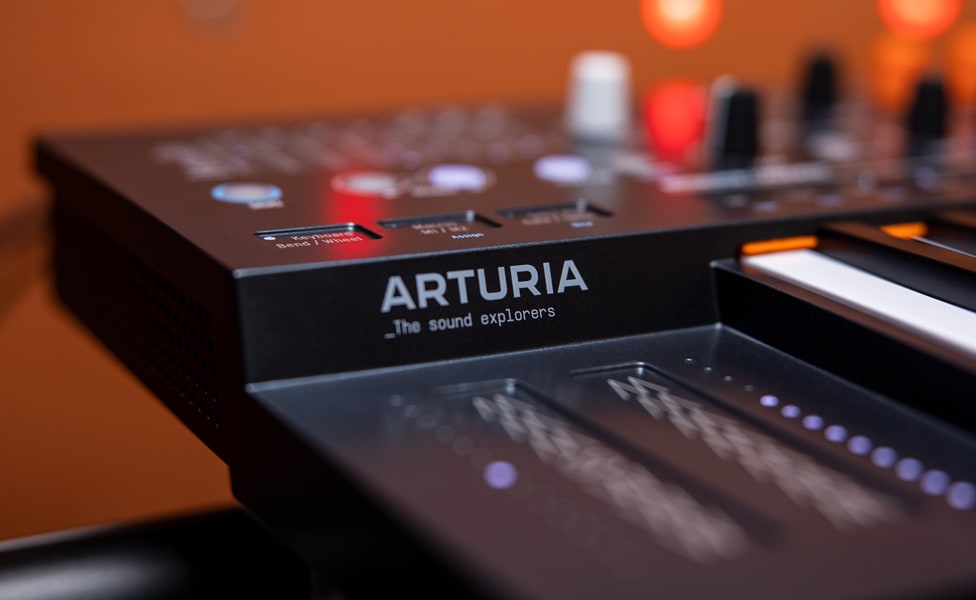
Okay, final question. The first time someone walks up to a MiniFreak at their local Guitar Center, which presets should they check out?
Definitely Impale, which is preset 5. The effects just make it like a crazy sound.
The next one would probably be preset 10, Geiger Counter, because there’s kind of like a fragile elegance to it. It's got this weird glitchy sound that the macros really reveal. The macros distort and kind of glitch out the sound. It's playable, but it's got this real digital flow I was mentioning at the beginning. It really has that.
For the third one, I will say preset 54, because I designed it! It's kind of a comb filter resonant sound. But there's something expressive about how you play it louder, and the sound just decays for longer. It has a real organic quality that I was going for.
So, I would give these three. But honestly, I'm so amazed with the library. There are 256 presets in the end, and all of the sound designers did an amazing job in general. All the sounds are, in my opinion, very easy to play, and they all have something a bit unusual to them. Each one of them—you can still play them. You can still fit them in a track, and they have some twist to them.










